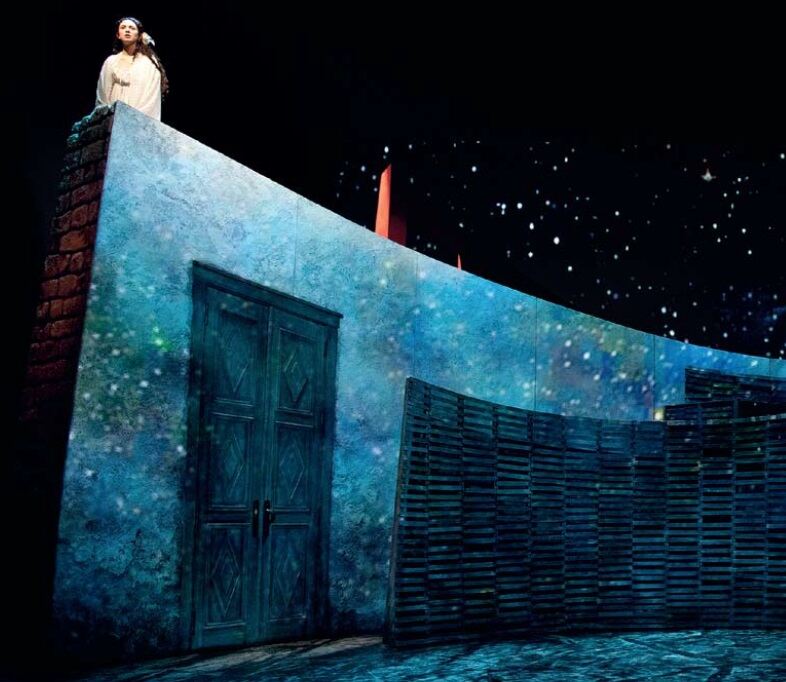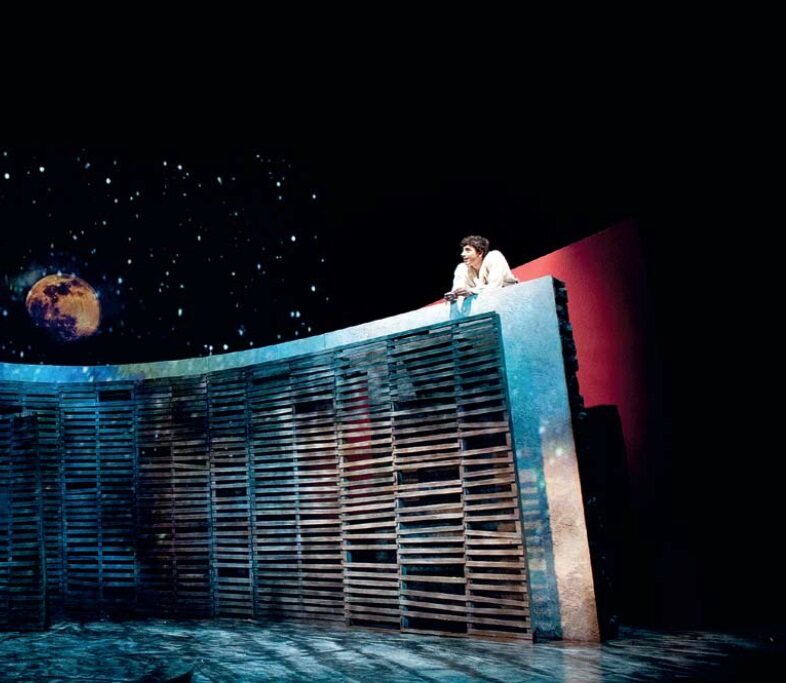Laird Williamson, DIRECTION: This production is set in Alta California in 1847, prior to the time of the Gold Rush and statehood. It’s about a year into the American occupation of California, and the military presence is evident in the background, sometimes in the foreground. The play’s two prominent families are Spanish aristocrats, with vast ranches, houses in town, living the good life—they’re being wooed by both England and France to link up with them. Our inspiration for the design included adobe homes in Monterey that were actually owned by such people. And, with the wall, we wanted to embrace the action, bring it downstage, hold it in. In the balcony scene, which you see in the photo above, the two lovers are elevated above the social situation and family conflict, meeting somewhere in the air, a holy place. They’re separate, but linked by the curve of the wall. The projections allowed us to make the settings specific or, as in this case, more abstract.


Photo by Jenny Graham
Michael Ganio, SCENIC DESIGN: One thing Laird wanted to do was make it clear that the adults in this story—the community—are responsible in many ways for the tragedy that occurs. The design sprang from the impulse to give people no place to hide: Think of being backed up against a wall till you have no place to go. Goya’s painting The Third of May 1808, of soldiers firing on unarmed civilians backed up against the side of a hill, was one inspiration for me. Another was the experience of seeing Richard Serra’s sculptural work at the Museum of Modern Art in New York City, his great, unrelenting shapes out of steel—those were the seeds for this design. And Laird had envisioned nonrealistic projections to suggest sky, the archetypal aspects of the story, the mystery of how it all plays out. I’ve known Laird since 1979, and Don for nearly as long, and I think that allows for a kind of intuitive, nonverbal communication—which was the case as we worked closely together on this production.
Don Darnutzer, LIGHTING DESIGN: Michael and I worked together on the projection aspects of the show. (I’m married to a set designer, so I’m always sympathetic to working in tight collaboration with other designers.) But Michael lives in Ashland and I live in Minneapolis, so our process consisted of trading lots of e-mail images back and forth, then sharing with Laird what we came up with. This set had multiple surfaces on which textures and colors and images could be projected—the rear cyc, the great curved wall, even the floor, which I always love to have fun with. For the balcony scene, Michael created a wonderful starlit sky by rear projection, and I brought the sky forward onto the wall, which in effect places the two young lovers floating in space. This scene is one of the great moments in theatre, so we went with a visual plan that reflected the emotions that the characters are feeling.
Shakespeare’s Romeo and Juliet, directed by Laird Williamson, runs through Nov. 4 at the Oregon Shakespeare Festival’s Angus Bowmer Theatre in Ashland, Ore. The production features scenic design by Michael Ganio, costume design by Susan Tsu, lighting design by Don Darnutzer, original music/sound design by David Reiffel, choreography by Alonzo Lee Moore IV, dramaturgy by Lydia G. Garcia, voice and text direction by David Carey, and fight direction by U. Jonathan Toppo. Above, Daniel José Molina as Romeo, right, and Alejandra Escalante as Juliet.

